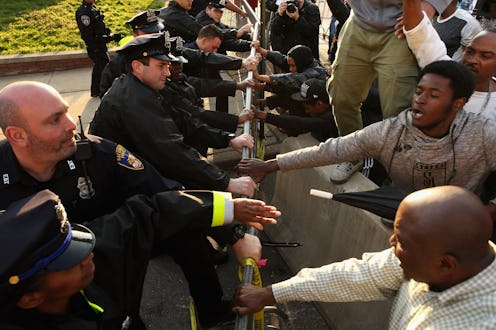News
What Percent Of Baltimore Is Black?
Protests in Baltimore over Freddie Gray's mysterious death suddenly turned from peaceful to violent Monday when a group of juveniles started throwing rocks at police and jumping on police vehicles, according to CNN. Police used tear gas and pepper bombs to deter the young people, and the Maryland National Guard has been alerted should they need to deploy rapidly, Maryland Gov. Larry Hogan said in a statement. Gray's death could be indicative of a larger race problem in Baltimore, a city with a high percentage of black residents.
Non-stop protests have taken over the city since 25-year-old Gray was apprehended and detained by the Baltimore City Police Department on April 12. Gray sustained a severe spinal injury while under police supervision and died a week later in the hospital. Police have yet to disclose the circumstances surrounding Gray's death after he was arrested.
Gray is the most recent death of an unarmed black person by white officers in the last few months. Questions about police brutality and racial tensions between police and the communities that they are supposed to protect have continued to grow. Unfortunately, the race problem seen in Ferguson and in other parts of the United States might be common in Baltimore as well, according to NPR.
Race In Baltimore — By The Numbers
According to the U.S. Census, 63.3 percent of Baltimore's population in 2013 was black and 31.6 percent white. About 23.8 percent of the city was below the federal poverty level. According to The Washington Post, the neighborhood where Gray was arrested is one of the poorest communities in Baltimore. Post reporter Petula Dvorak spoke to 71-year-old Sarah Chestnut, who lives in the Sandtown neighborhood where Gray was taken into custody, about the condition of Baltimore and its safety for black people. She told the Post that her nephew was shot in Baltimore at a corner not far from Gray's house.
I’ve been here since 1971, and I don’t think all this is going to make any difference. I brought my nephew from Detroit to live here. I thought it would be better. He was shot eight times in the back. ... Right now, Detroit’s better than this place.
Civil rights advocate Rev. Jesse Jackson spoke at Gray's funeral Monday about the contrast between Baltimore's poor and mostly black west side and the city's prosperous downtown area, according to The New York Times.
Sixteen thousand abandoned or vacant homes, 25 percent unemployment — we don’t need more police, we need more jobs. Why can’t the west side get the same things downtown gets?
What Does This Mean For Baltimore Police?
Charles Thomas, who has lived in Gray's neighborhood for nine years, was outside when he heard Gray screaming, according to The Washington Post. He said Gray's legs dragged behind him and he was limp. Thomas, a former prison guard, said Gray's death might make people pay attention "to what's really going on" in Baltimore.
It’s like we live under martial law. I understand that police have a job to do. I did a job like that for years. But here, the police don’t know us. They don’t know the neighbors.
Leonard Hamm, a former commissioner of the Baltimore Police Department from 2004 to 2007, also cited a "disconnect" between police and the Baltimore community, according to NPR.
We've had some other problems with African-Americans dying in police custody and at the hands of police officers here in Baltimore city. This is possibly the spark that's going to ignite change, real change, in this city, and with the Baltimore Police Department.
Current Baltimore City Police Commissioner Anthony Batts even discussed racism in Baltimore during a national task force meeting on policing in February, according to The Baltimore Sun. He said that during his 30 years as an officer on the West Coast, there was a greater focus on diversity. The Sun said he previously described the Baltimore police as too "one-dimensional." He spoke to law enforcement leaders in a speech:
When I go to Baltimore, on the East Coast, I'm dealing with 1950s-level black-and-white racism. It's taken a step back. Everything's either black or everything's white, and we're dealing with that as a community.
The Sun said a spokesperson for Batts declined to elaborate on that statement. But he did say the Baltimore force needed to be more versatile in addressing the economic and social issues behind crime.
People kept telling me as I toured the city that kids have nothing to do in the summertime. They don't even have food. They don't even have anything to eat. How can you address that?
The U.S. Department of Justice has since opened an investigation into the Baltimore City Police Department and Gray's death.
Images: Getty Images (5)
